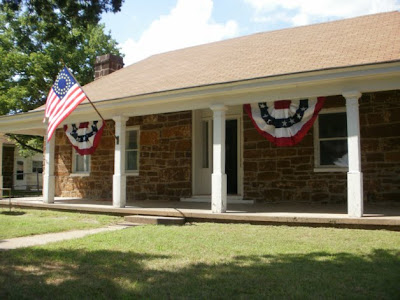On Friday evening, July 9, 2010, the 2nd Annual Reunion of the Forsythe Scouts Descendants was held at the former Fort Harker Junior Officers Quarters in Kanopolis, Kansas.
Wait - that's not a very good beginning. How about, "Who were the Forsythe Scouts?"
Turns out Fort Harker - which started as Fort Ellsworth, and then renamed Harker in 1866 - became in the spring of 1867 the permanent headquarters of the famed U.S. Seventh Cavalry. Fort Harker also served as the base for all cavalry operations west of the Missouri River and was among other things the funnel through which the lumber and other materials came that built the city of Wichita.
In the summer of 1868 General Phil Sheridan, in charge of the Army Department of the Missouri, ordered the creation of a special force of civilian scouts under the command of Major George A. Forsythe to be recruited from around Forts Harker and Hays. These scouts were Civil War veterans trained in tracking that hopefully could do what the regular Army Cavalrymen could not - track and run down the various Indian bands that were causing havoc across central and western Kansas.
Forsythe's Scouts followed the Indians west across Kansas and into Colorado Territory, where on September 17, 1868, they were attacked by several hundred Cheyennes and Sioux. The fifty Scouts killed their horses and took cover behind them on an island in the Arickaree Fork of the Republican River in northeast Colorado. There they were besieged for nine days and several were killed until two Scouts, who had slipped out one night past the Indians, brought back a rescue column from Fort Wallace. The surviving Scouts became nationally famous.
Fort Harker was home for some of the biggest names in American Western history - General Philip Sheridan, General George Armstrong Custer, General Winfield Hancock, Colonel Henry Inman, General Nelson Miles, and even newspaperman Henry Stanley of Stanley and Livingstone fame. By 1873 the Indian Wars had progressed far west of Fort Harker and, with the need for the fort long past, it was formally closed. The post reservation was sold to private interests in 1884 and three years later the city of Kanopolis was layed out atop the old fort site. Four sandstone structures - The Guardhouse, two Junior Officer Quarters, and the Commanding Officer's Quarters - all became private homes. The importance of Fort Harker faded from memory as other forts such as Hays received more modern attention.
One of the two surviving Junior Officers Quarters. This one is now owned by the Ellsworth County Historical Society and has been restored.
The desk used by Colonel Henry Inman - for whom Inman, Kansas was named - can be seen in the Junior Officers Quarters.
The bunks for the Junior Officers.
The Commanding Officer's Quarters stands to the south across the street from the Junior Officer Quarters. It was recently acquired by the Ellsworth County Historical Society and is in the process of restoration.
One of the restored sandstone fireplaces in the Commanding Officer's Quarters.
McLain's Light Artillery bivoacked the entire weekend on the Junior Officers Quarters grounds.
Two members of McLain's Light Artillery, doing what their counterparts were probably doing 145 years ago - drinking coffee and having a smoke.
Members of the McLain's Light Artillery getting their 12lb Mountain Howitzer ready for firing.
They're ready to fire!
The cannon can fire cannonballs 1000 yards; even the concussion from a blank charge shook the ground and knocked plaster from walls.
When the cannon went off, people piled out of buildings all over town, wondering what that terrific explosion was!
From 5 PM to 7PM there was a fundraising Hamburger Feed in front of the Commanding Officer's Quarters and was attended by several hundred hungry people.
The Wild Women of the Frontier were in attendance as well!
A tent was set up in front of the Junior Officer's Quarters for the evening presentations. Gathered were several descendants of the Forsythe Scouts in addition to those interested in the entire proceedings.
Jim "The Cowboy" Gray, left, and "Big Nose Kate" await the start of the festivities. Jim organized the Reunion and is a noted historian and storyteller. Emphasize that storytelling part!
Jim Gray kicks off the evening presentations.
As a special treat, Jamilee (Page) Shank, displayed Scout Jack Peate’s Henry rifle that he carried in the relief column for those trapped at Beecher Island. For being a hundred and fifty years old, the rifle appears to be in remarkable condition.
The descendants of the Forsythe Scouts in attendence: Back Row, Left to Right: Mary Lou (Eutsler) Percival, John Eutsler, Mickie Alderdice, Marilyn (Day) Child, Leigh Geyer, Jamilee (Page) Shank and her daughter, Susan. Front Row, Archie Eutsler and Kirk Healy.
U.S. Army Lt. Colonel Dennis Clark from Fort Leavenworth was the featured speaker. He gave a fascinating Powerpoint program in which he presented his argument that the present agreed-upon location of the Battle of Beecher Island, now a Colorado State Park, is incorrect. The battle, he feels, took place some seven miles farther upstream than the present park.
In his presentation Lt. Colonel Clark noted that the present battle site was decided upon in 1898, thirty years after the battle. His belief is that the stories of an "altercation" that the local populace had heard of when they homesteaded the area was actually about an 1857 incident between the Indians and the U.S. Cavalry in precisely the same region. His belief that the current battle site is incorrect is backed up by the fact that ever since not one artifact from the 1868 battle has ever turned up - not even a single bullet or arrowhead, or even a horse bone. Clark then let be wn that within two years there will be a major archeological dig at the site he believes to be the true battleground. The Reunion then ended with much discussion and many interesting questions.






















No comments:
Post a Comment